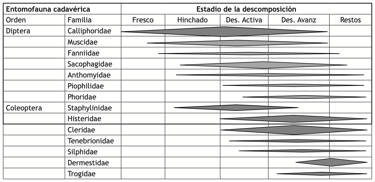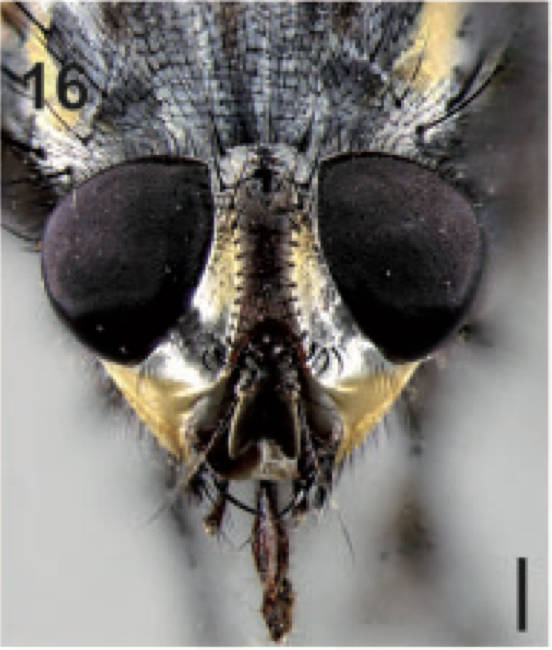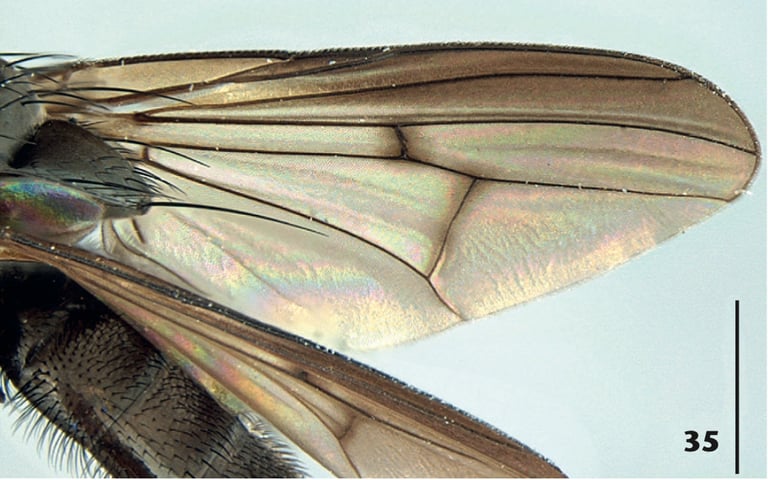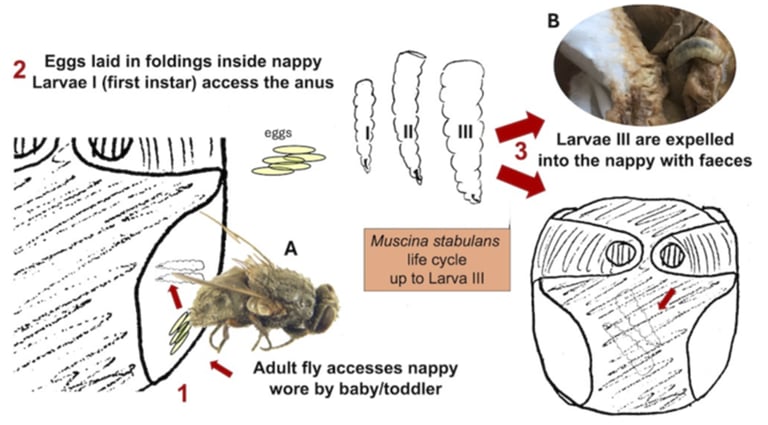Forensic Entomology
Mulieri PR, Mello-Patiu CA, & Aballay FH. 2017
Taxonomic revision of Lipoptilocnema (Diptera: Sarcophagidae), with notes on natural history and forensic importance of its species.
Journal of Medical Entomology 54, 50-75.
Lipoptilocnema Townsend is a small genus of Neotropical Sarcophaginae with a distinctive genitalic morphology. This genus is revised based on the examination of the type series and large numbers of specimens of the seven previously known species, plus three new ones herein described, one from Argentina (L. delfinado Mulieri and Mello-Patiu, sp. nov.), and two from Brazil (L. savana Mulieri and Mello-Patiu, sp. nov. and L. tibanae Mulieri and Mello-Patiu, sp. nov.). All species are described or redescribed and illustrated. Distribution maps and a key for male identification are provided. The taxonomic position of this genus is reviewed, and the interpretation of phallic structures is discussed. Notes on the natural history of Lipoptilocnema species are provided, and their potential importance as PMI indicators is highlighted, including the first record of Lipoptilocnema reared from a dead human body.






Aballay FH, Saloña Bordas MI, & Perotti MA. 2024
A first record of a suspected intestinal myiasis caused by Muscina stabulans (Fallén 1817) (Diptera: Muscidae) in Southern South America.
Parasitology in press.
We report a case of a suspected intestinal myiasis of a child from Southeast Argentina. Diptera larvae were sampled by a physician from the nappy worn by the child and submitted for exam- ination and identification to the Laboratorio de Artrópodos (Universidad Nacional de Mar del Plata). Based on diagnosis of the anterior and posterior spiracles and mouthparts, the larvae were identified as the false stable fly Muscina stabulans (Fallén, 1817) (Diptera: Muscidae). A comparison of diagnostic characters between Argentinean and European third instars of this species is presented. Muscina stabulans is a prevalent species in the district of General Pueyrredón, Buenos Aires province, where the case occurred. Its abundance in the area coincidentally peaked at the time of the infestation. This is the 1st report of M. stabulans as a suspect of intestinal myiasis for the whole of the southern cone of South America (Chile and Argentina).
Grisales D, Lecheta MC, Aballay FH, & de Carvalho CJB. 2016
A key and checklist to the Neotropical forensically important "Little House Flies" (Diptera: Fanniidae).
Zoologia 33, e20160054.
Fanniidae (Insecta: Diptera) is a relatively small family (ca. 350 spp.) with five genera, of which Fannia Robineau-Desvoidy, 1830 and Euryomma Stein, 1899 have Neotropical distributions. Some of these species are almost always found in forensic studies. Forensically relevant species have been neglected, despite recent forensic studies that suggest their importance for estimating post-mortem interval (PMI). Thus, current and updated keys to identify adults or larvae on carcasses are unavailable for the most important species. While immature stages are important in estimating PMI, evidence suggests that adults (Fanniidae as well as other families) may also be useful for this purpose. Here we provide a key to males of the species of Fanniidae (found on corpses and other decomposing organic matter) with a checklist of species that have been used in forensics in the Neotropical region. The key comprises all 38 species of Fannia and Euryomma that have already been successfully used in forensics, and species that are potentially useful for estimating PMI. These records were found after reviews of the literature and data from entomological collections. Photographs and illustrations of the main characters in the key are provided.
Lambiase S & Perotti MA. 2019
Using human head lice to unravel neglect and cause of death.
Parasitology 146, 678-684.
Despite the common association of human lice with abandoned or neglected people, no procedure to assess pediculosis, aimed to detect signs of neglect, exists. Investigating the two most common forms of head louse infestation, regular and severe, we define lice-markers of neglect and develop a protocol and survey form to record and assess pediculosis. The study of head lice from a deceased victim of neglect helped unravel time-length since death, frequency of exposure to neglect and the cause and circumstances related to the death. Nit-clusters are markers of neglect, indicating length and frequency of neglect episodes. In the case study used here that culminated in the death of the victim, sustained abandonment started circa 2 years before discovery. The lice suggested that death was caused by overconsumption of a powerful calcium channel blocker, an antihypertensive, an excess of which in lice food supply (blood) stops oogenesis. Despite hosting thousands of adult females on the hair, lice reproduction stopped and nits were no longer developed or deposited on the hairs at the root end. This short distance of the shaft with no nits provided a time estimation of overdosing of almost 2 months before death.


Centeno N D & Aballay HF. 2020
Entomología forense [Forensic entomology].
Biodiversidad de Artrópodos Argentinos. Volumen 4. Roig-Juñet S, Claps L E, & Morrone J (eds). San Miguel de Tucumán: Instituto Superior de Entomología “Dr. Abraham Willink” (INSUE); 31-44.
Although recent in Argentina, the forensic entomological studies are increasing quickly as much in their basic and applied aspects. The study of the scavenger insects allows to contribute relevant information to the forensic investigators. The cadaveric fauna includes the insects that happen in the corpse to feed and to breed their immature stages, mainly including the orders Diptera and Coleoptera. These insects are associated with decomposition stages that they change with time; due to this, their study allows the estimation of the spent time or to know a potential alteration of the normal process. In this chapter the main results of the experiments done in different regions from the country, as well as the collected data of forensic cases are shown. Also the main methods for the fieldwork, the collection and preservation of the specimens, the rearing procedures and the analysis of the entomological data are explained briefly.


Aballay FH, Flores GE, Silvestro VA, Zanetti NI, & Centeno ND. 2016
An illustrated key to, and diagnoses of the species of Tenebrionidae (Coleoptera) associated with decaying carcasses in Argentina.
Annales Zoologici 66, 703-726.
Flores G E & Aballay FH. 2015
Two Evaniosomini species (Coleoptera: Tenebrionidae) associated with decaying carcasses in Argentina, with remarks on the tribal assignment of Achanius Erichson.
Coleopterists Bulletin 69, 167-179.
Remedios-De León M, Aballay FH, Domínguez MC, & González-Vainer P. 2015
Fannia fusconotata and Fannia sanihue (Diptera: Fanniidae): First records in Uruguay and distribution extension.
Check List 11, 1734.
Aballay FH, Chani-Posse MR, Rosana Ayon M, Belen Maldonado M, & Centeno ND. 2014
An illustrated key to and diagnoses of the species of Staphylinidae (Coleoptera) associated with decaying carcasses in Argentina.
Zootaxa 3860, 101-124.
Aballay FH, Arriagada G, Flores GE, & Centeno ND. 2013
An illustrated key to and diagnoses of the species of Histeridae (Coleoptera) associated with decaying carcasses in Argentina.
ZooKeys 261, 61-84.
Mulieri PH, Mariluis JC, & Aballay FH. 2012
Two species of Microcerella (Diptera: Sarcophagidae) found in highland arid landscapes of Argentina during Forensic Studies.
Journal of Medical Entomology 49, 183-191.
Aballay FH, Murúa AF, Acosta JC, & Centeno ND. 2012
Succession of carrion fauna in the arid region of San Juan Province, Argentina, and its forensic relevance.
Neotropical Entomology 41, 27-31.
Aballay FH, Domínguez MC, & Fernández Campón F. 2012
Adult Fanniidae associated to pig carcasses during the winter season in a semiarid environment: Initial examination of their potential as complementary PMI indicators.
Forensic Science International 219, 284.e1-284.e2844.
Aballay FH, Fernández Campón F, Mulieri PR, & Urquiza SV. 2011
Sarcophagidae (Diptera) de importancia forense en la puna de Catamarca, Argentina: La ovoviviparidad como ventaja en condiciones de extrema aridez [Sarcophagidae (Diptera) of forensic importance at a high altitude desert in Catamarca, Argentina: Ovoviviparity as an advantage under extreme arid conditions].
Revista de la Sociedad Entomologica Argentina 70, 255-266.
Domínguez MC & Aballay F. 2008
A new species of the genus Fannia Robineau-Desvoidy (Diptera: Fanniidae) collected on pig carrion in Mendoza, Argentina.
Annales Zoologici 58, 819-824.
Aballay FH, Murúa AF, Acosta JC, & Centeno N. 2008
Primer registro de artropodofauna cadavérica en sustratos humanos y animales en San Juan, Argentina [First record of cadaverous arthropod fauna in human and animal substrates in San Juan, Argentinas].
Revista de la Sociedad Entomologica Argentina 67, 157-163.